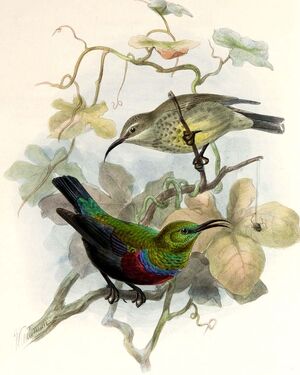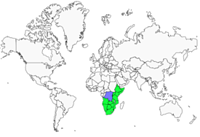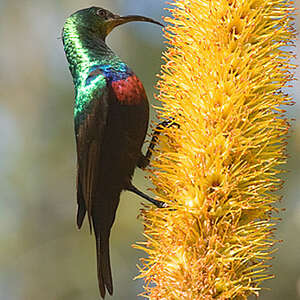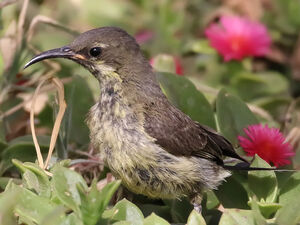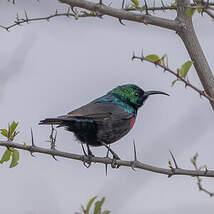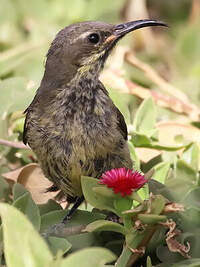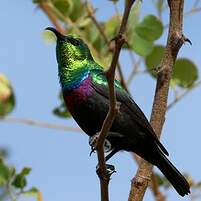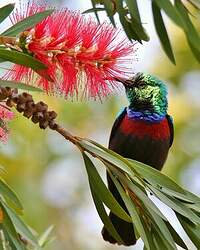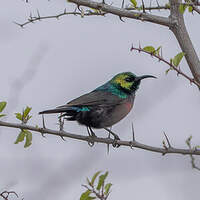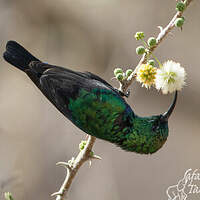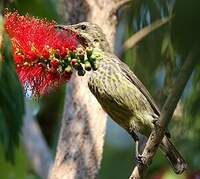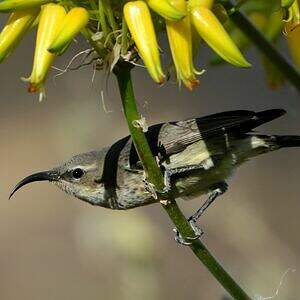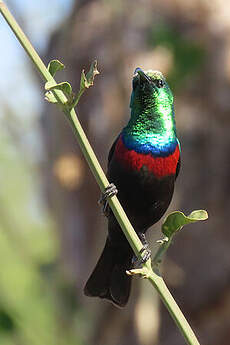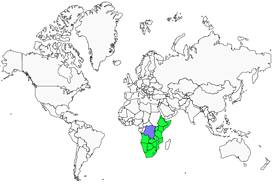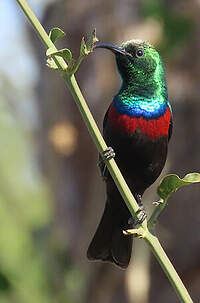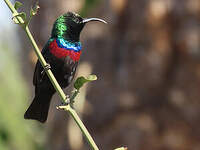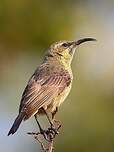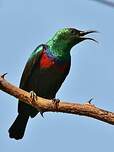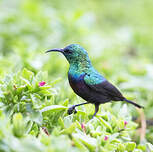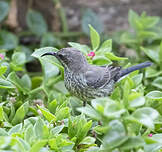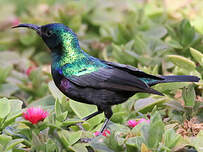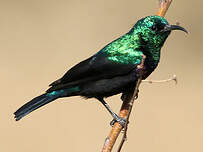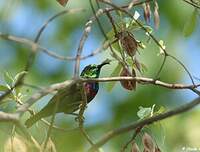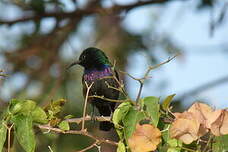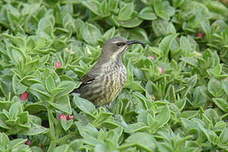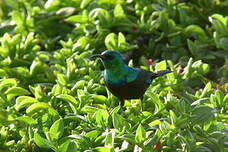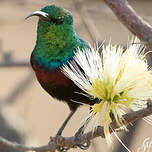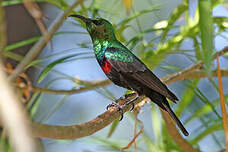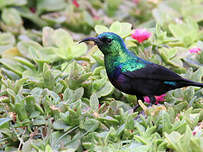Marico Sunbird
Cinnyris mariquensis - Souimanga de Mariqua Souimanga du Marico
Identification
The Marico Sunbird is a small sunbird with distinct sexual dimorphism. The adult male has an entirely metallic green head, throat and back to the rump including the scapulars with golden reflections on the head, while the beak, lores and the contour of the eyes are black, the iris is dark brown. The rectrices are dark brown and the two outer feathers are bordered with metallic green. The wings are dark brown but slightly lighter than the tail feathers. The top of the chest is marked with two bands of color: the base of the throat is surrounded by a narrow iridescent dark blue-violet band, below a wide breast band is purple-brown. In the subspecies Cinnyris mariquensis osiris this breast band is mixed with iridescent purple feathers. The abdomen, the flanks, the under-tail coverts and the wings are black. The legs are black. The subspecies Cinnyris mariquensis suahelicus has a shorter beak than the nominal subspecies. The female is distinguished from the male by its upper parts brown and its lower parts light yellow-brown. It has a light brown white eyebrow and yellow-brown mustaches contrasting with the rest of the brown head. The remiges and rectrices are much darker brown. The outer feathers of the rectrices have a white patch on the outer edges. The throat and chest are whitish-dull with variable amounts of thick black streaks. The abdomen tinged with pale yellow also has brown patches. The undertail coverts are white-fawn with black-brown and white streaks. The beak and legs are black as the male. The juvenile resembles the female. The immature male is distinguished from the female by a black or gray throat bordered with white. The lower parts are yellow with strong black streaks on the chest.A conspicuous spot stands out on the shoulder. The tertiary remiges are tinted light brown, most prominently on the secondaries. The central rectrices are a bright dark blue with a hint of green. The outer rectrices are brown with white edges above and below.
Subspecific information 3 subspecies
- Cinnyris mariquensis mariquensis (wc and s Angola and ne Namibia to sw Zambia, Botswana, c, s Zimbabwe, n South Africa and s Mozambique.)
- Cinnyris mariquensis osiris (Eritrea and Ethiopia to se Sudan, n Uganda and n Kenya)
- Cinnyris mariquensis suahelicus (c Uganda to c Kenya, Tanzania and ne Zambia)
Foreign names
- Souimanga de Mariqua,
- Suimanga del Marico,
- nectarínia-do-marico,
- Bindennektarvogel,
- Mariqua-nektármadár,
- Maricohoningzuiger,
- Nettarinia del Mariqua,
- maricosolfågel,
- Akasiesolfugl,
- nektárovka pásavoprsá,
- strdimil mariquaský,
- Mariquasolfugl,
- viinivyömedestäjä,
- Maricosuikerbekkie,
- suimanga de Marico,
- nektarnik czarnoskrzydły,
- Зеленоспинная нектарница,
- ヒガシニシキタイヨウチョウ,
- 马里基花蜜鸟,
- 馬里花蜜鳥,
Voice song and cries
Habitat
Like most of its peers, the Marico Sunbird feeds, reproduces and nests in the clear and densely wooded savannah environments, particularly dry and arid acacia savannahs. It also frequents the edges of riverine deciduous forests and forests bordering marshes, lakes, dams and streams. It can easily be observed in gardens and wet woods. It is usually a low to medium altitude bird but is more common between 1,000 and 2,000 meters.
Behaviour character trait
From what is observed in the field, the Marico Sunbird appears to be a nomadic bird in certain regions.
This is the case in Uganda, Mozambique and Zimbabwe where it moves to higher altitudes from May to June to reproduce, then moves back to lower altitudes from November to December. There has also been observed a movement of populations towards the southwest, particularly in South Africa, where the species is usually not present. Explanations for this migratory phenomenon could be due to the large droughts and floods of the last decade which would push the populations to seek more favorable environments. The Marico Sunbird is a monogamous species throughout its lifetime. It can be seen alone or in pairs, and it can be observed on the ground when it looks for its food. It can also attack its prey in flight which it will then take away to a secluded area to cut into small pieces and swallow afterwards. The Marico Sunbird has an enhanced night vision, so it can also feed at night which provides it with an abundance of additional prey in addition to its daytime prey such as nocturnal insects.Flight
The movements of the Marico Sunbird are varied. The flight for its nuptial migrations, albeit short distances, is made in a direct flight. It will preferably fly over natural landscapes such as rivers and valleys which form natural flight paths and in which the bird will have many opportunities to feed. It can practice hovering flight to feed on nectar from flowers and the butterfly flight in front of the female it courts.
Dietfeeding habits
The Marico Sunbird is a frugivorous but also insectivorous species. The list of trees, lianas or flowering bushes they visit is quite long: these include Acacia, Aloe, Bauhinia, Cadaba, Callistemon, Capparis, Crotolaria, Erythrina, Geranium, Grevillea, Jacaranda, Kigelia, Kniphofia, Leonotis, Schotia, Tecoma and Thevetia.
During its investigations among all this vegetation, it collects insects under the leaves and on the ground: these include Diptera, Lepidoptera, Hymenoptera and termites, not to mention the spiders it can take directly from the web. It hunts by flying or gliding. It feeds alone, in pairs or with other sunbirds.Reproduction nesting
The breeding season of the Marico Sunbird spans the entire year, depending on its distribution area. Nesting is recorded in March in Somalia, in May in Ethiopia, in February, June, August, September and November in Uganda, in February, September and October in Zambia, in November in Botswana, in July in Mozambique, from August to April in South Africa and all year round except August and October in Tanzania and August, November and December in Zimbabwe. Except for the areas where altitude and mating movements are recorded, the male maintains and monitors its territory throughout the year.
To do this, he stands upright on top of the trees and engages in vocal duels with the other males present in his environment. To seduce his partner, the male flies around the female, hovers in front of her and then lands next to her. The nest is built by the female. It is high up in the tree canopy, up to 8 meters high, that the female builds it without the help of the male, in 6 to 12 days. It is protected from predators by the branches and dense green foliage that surround it. Oval in shape, the nest has a small porch made of blades of grass above the entrance. Its thick walls are made of white down or woolly fabrics and grass. In addition to its location, the outside is decorated with dark materials to blend as much as possible into the vegetation. The female uses bark, seeds, flowers and feathers. Everything is held together by spider webs that the female harvests herself. The nest can be used on two broods per year and on several years. The female lays between 1 and 3 eggs, white-gray or whitish green, heavily streaked or stained with pale brown, black, gray or green-olive.She incubates alone for about 13 to 15 days. Rarely for this species, our female is in charge of feeding her chicks entirely, the male will only intervene once the youngsters have taken flight. They stay dependent on their parents for several weeks, returning to the nest for the night. The Marico Sunbird's nest is parasitized by the Diederik Cuckoo and the Klaas's Cuckoo.Geographic range
The Marico Sunbird inhabits two distinct regions of Africa. One population ranges from Eritrea to Tanzania, encompassing two subspecies: Cinnyris mariquensis osiris and Cinnyris mariquensis suahelicus. The other population, Cinnyris mariquensis mariquensis, is found in sub-Saharan Africa, ranging from Angola and southwestern Zambia to southern Africa. This population is locally common from Namibia to Botswana, passing through Zimbabwe, southern Mozambique, and northern and northeastern South Africa. It is less abundant in southern Tanzania.
Threats - protection
IUCN conservation status
concern
in the Wild
threatened
evaluated
The Marico Sunbird is generally common throughout most of its extremely wide range, so it is not globally threatened and its population is stable. Its presence in several protected areas, national parks and reserves (Awash in Ethiopia, Lake Mburo in Uganda, Shaba and Buffalo Springs in Kenya, Serengeti and Tarangire in Tanzania, Etosha in Namibia) give it a positive outlook for the future. Unfortunately, there is still no knowledge of the future consequences of the repeated droughts in these areas.
Sources of information
- IOC World Bird List (v13.2), Gill, F and D Donsker (Eds). 2023.
- Birds of the Horn of Africa, Nigel Redman
- Birds of the World, The Cornell Lab of Ornithology
- BirdLife International, BirdLife International
- African Bird Club,
- Birds of Southern Africa, Tony Roocroft
- Biodiversity explorer The web of life in Southern Africa,
- Wikipedia (English version),
Other sources of interest
 Specification sheet created on
16/07/2023 by Nathalie Santa Maria
Specification sheet created on
16/07/2023 by Nathalie Santa MariaTranslation by AI Oiseaux.net
published: 22-04-2023 - Updated: 22-04-2023
© 1996-2024 Oiseaux.net
- Accipitriformes
- Aegotheliformes
- Anseriformes
- Apodiformes
- Apterygiformes
- Bucerotiformes
- Caprimulgiformes
- Cariamiformes
- Casuariiformes
- Charadriiformes
- Ciconiiformes
- Coliiformes
- Columbiformes
- Coraciiformes
- Cuculiformes
- Eurypygiformes
- Falconiformes
- Galliformes
- Gaviiformes
- Gruiformes
- Leptosomiformes
- Mesitornithiformes
- Musophagiformes
- Nyctibiiformes
- Opisthocomiformes
- Otidiformes
- Passeriformes
- Pelecaniformes
- Phaethontiformes
- Phoenicopteriformes
- Piciformes
- Podargiformes
- Podicipediformes
- Procellariiformes
- Psittaciformes
- Pterocliformes
- Rheiformes
- Sphenisciformes
- Steatornithiformes
- Strigiformes
- Struthioniformes
- Suliformes
- Tinamiformes
- Trogoniformes

